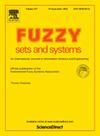Approximate state reduction of fuzzy finite automata
IF 2.7
1区 数学
Q2 COMPUTER SCIENCE, THEORY & METHODS
引用次数: 0
Abstract
State reduction of fuzzy automata aims to efficiently construct a suitably small fuzzy automaton equivalent to a given one. It is a significant and well-studied problem in automata theory due to its practical applications in various fields. If we relax the requirement for exact equivalence, then we talk about the approximate state reduction problem, which has gained attention only recently. There are two approaches to approximate state reduction: one seeks approximate equivalence to a specified threshold, while the other aims for exact equivalence for length-bounded words. These two approaches have been considered separately. In this paper, we demonstrate that both approaches, and even their combination, can be achieved by merging indistinguishable states of a fuzzy automaton through the use of sequences of fuzzy relations that we introduce in this paper. We provide characterizations of these sequences, and show that they are closely related to certain approximate simulations for fuzzy automata that emerged in the recent literature. However, their subtle differences significantly affect the process of approximate state reduction. By formally proving this distinction, we generalize some well-known results and offer new insight into approximate state reduction. We discuss how all forms of approximate state reduction can be realized and provide algorithms for calculating the proposed sequences and performing the reductions, along with illustrative examples.
模糊有限自动机的近似状态约简
模糊自动机的状态约简旨在有效地构造与给定自动机等价的适当小的模糊自动机。由于它在各个领域的实际应用,它是自动机理论中一个重要的、研究得很好的问题。如果我们放宽对精确等价的要求,那么我们讨论的是最近才引起注意的近似状态约简问题。近似状态约简有两种方法:一种寻求与指定阈值的近似等价,而另一种旨在对有长度限制的单词进行精确等价。这两种方法已分别加以考虑。在本文中,我们证明了这两种方法,甚至它们的组合,可以通过使用我们在本文中引入的模糊关系序列合并模糊自动机的不可区分状态来实现。我们提供了这些序列的特征,并表明它们与最近文献中出现的模糊自动机的某些近似模拟密切相关。然而,它们的细微差别显著影响了近似状态约简的过程。通过正式证明这一区别,我们推广了一些众所周知的结果,并为近似状态约简提供了新的见解。我们讨论了如何实现所有形式的近似状态约简,并提供了计算所提出序列和执行约简的算法,以及说明性示例。
本文章由计算机程序翻译,如有差异,请以英文原文为准。
求助全文
约1分钟内获得全文
求助全文
来源期刊

Fuzzy Sets and Systems
数学-计算机:理论方法
CiteScore
6.50
自引率
17.90%
发文量
321
审稿时长
6.1 months
期刊介绍:
Since its launching in 1978, the journal Fuzzy Sets and Systems has been devoted to the international advancement of the theory and application of fuzzy sets and systems. The theory of fuzzy sets now encompasses a well organized corpus of basic notions including (and not restricted to) aggregation operations, a generalized theory of relations, specific measures of information content, a calculus of fuzzy numbers. Fuzzy sets are also the cornerstone of a non-additive uncertainty theory, namely possibility theory, and of a versatile tool for both linguistic and numerical modeling: fuzzy rule-based systems. Numerous works now combine fuzzy concepts with other scientific disciplines as well as modern technologies.
In mathematics fuzzy sets have triggered new research topics in connection with category theory, topology, algebra, analysis. Fuzzy sets are also part of a recent trend in the study of generalized measures and integrals, and are combined with statistical methods. Furthermore, fuzzy sets have strong logical underpinnings in the tradition of many-valued logics.
 求助内容:
求助内容: 应助结果提醒方式:
应助结果提醒方式:


